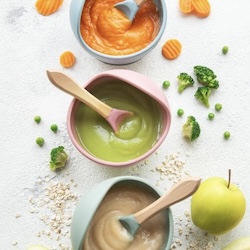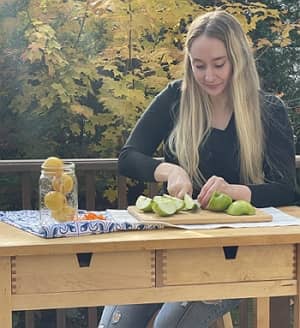Are you curious about making homemade baby food but unsure where to start? Check out our latest blog on everything you need to know about creating healthy, nutritious meals for your little one at home!
When feeding infants and children, it’s easy to get swept up in all the processed products on the grocery shelves, claiming to be packed with nutrients for your kids and offering a simple solution for busy families. However, feeding your children should be done with care. To support proper growth and development, you want to choose the best ingredients for them and opt for the most nutritious meals.
Making homemade meals for your infant and children may feel like a daunting task, but it has many benefits, both in terms of cost and nutrition for your family.
In this post, we’ll explore the benefits of DIY baby food, provide helpful tips on getting started, and share easy, delicious recipes.

Benefits of Homemade Baby Food
Proper Nutrition:
Homemade baby food puts you in complete control of what your baby is eating. You can select the highest quality ingredients, ensuring a wide variety of essential nutrients tailored to their needs. This means a diet rich in fruits, vegetables, proteins, and healthy fats—without preservatives, additives, or the high sugar content that often comes with store-bought baby food.
Developing Tastes and Preferences:
Babies begin to form their tastes and preferences from their first feed. Preparing your baby’s food allows you to expose them to fresh flavors and textures, supporting them in building a palate for plant-forward meals. Additionally, homemade food lets you introduce potential allergens, like nuts or eggs, at a recommended pace.
Being Fiscally Responsible:
Preparing food for your baby at home is more affordable than purchasing pre-packaged options. Buying ingredients in bulk, focusing on what’s in season, and using family-friendly recipes can help you stick to your budget while providing optimal nutrition for your baby.
How to get started with making your baby food:
- Set Yourself Up for Success: Make sure you have the right equipment, such as a blender, food processor, steamer, masher, and storage containers. Designating certain containers just for baby food helps prevent cross-contamination and ensures you’re always prepared.
- Educate Yourself on Proper Food Safety: Follow all appropriate food safety guidelines, including washing hands and utensils, rinsing produce, and cooking animal products to the proper internal temperatures. Store prepared food for no more than 3 days in the fridge or 3 months in the freezer.
- One ingredient at a time. Decide on an order of exposure, start with one ingredient at a time. First solids are usually pureed fruit and/or vegetables. For example banana mash or sweet potato puree. By serving one ingredient at a time, you can monitor for an allergic reaction, as well as take note of your baby’s overall reaction. Did they like it? How much of it did they eat?
Easy Homemade Baby Food Recipes
Once your infant has passed the single-ingredient phase, and is now ready for multiple ingredients per meal, here are some recipes to try:
Wash all produce well before handling!
Apple and Pear Puree
- Ingredients: 1 apple, 1 pear, and cinnamon
- Directions: 1) Peel, core and chop the apple. 2) Steam the peeled apple chunks until soft. 3) Purée the apple with peeled pear chunks in a food processor or blender until smooth. 4) Sprinkle with cinnamon.
Banana and Avocado Cream
- Ingredients: 1 ripe banana, 1 ripe avocado
- Directions: Peel and mash the banana and avocado together until creamy. Serve immediately.
Zucchini Potato Puree
- Ingredients: 4 cups zucchini, 3/8 cups potatoes, water, 1 tbsp olive oil
- Directions: 1) Peel and slice zucchini and potatoes 2) Steam both in a steamer basket (~10 minutes) 3) Blend softened vegetables with olive oil in a food processor or blender.
Homemade baby food is a fun and nutritious way to transition your infant to solids. Not only will this ensure your baby is eating to meet their nutrition and developmental needs, but it is budget-friendly for your family. Using this guide for preparation, safety tips, and DIY baby food recipes you can get started feeding your little one with ease.
To learn more about what Dining With Nature offers for pediatric nutrition care – hit the Explore The DWN Programs button below or take a look at our Services page.

